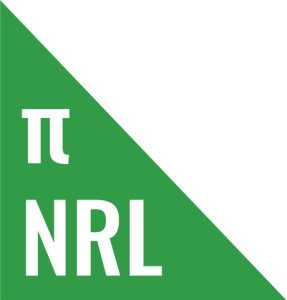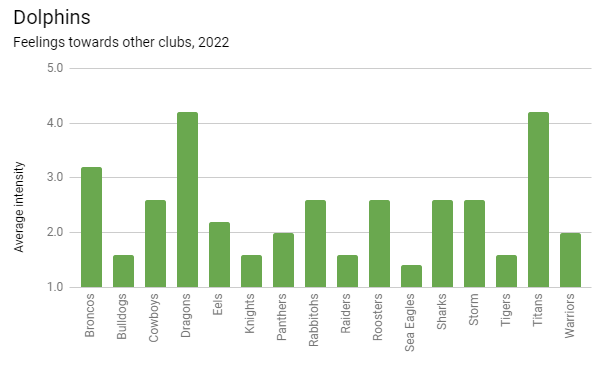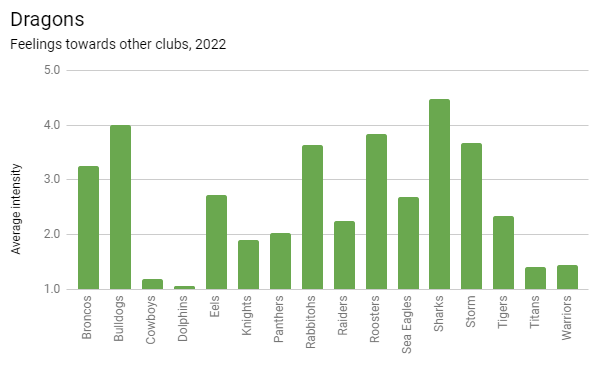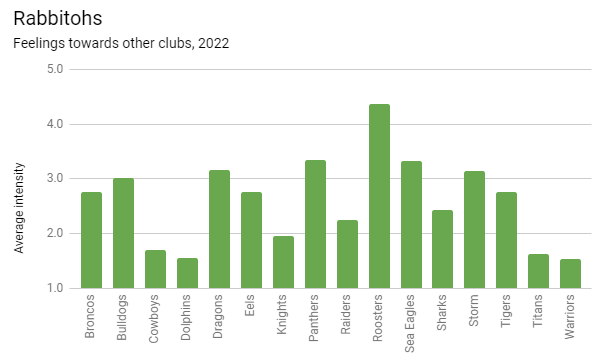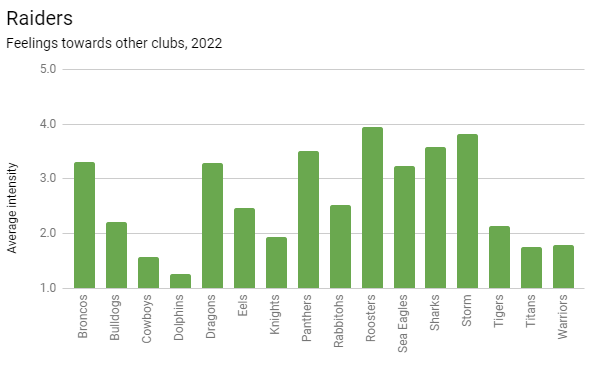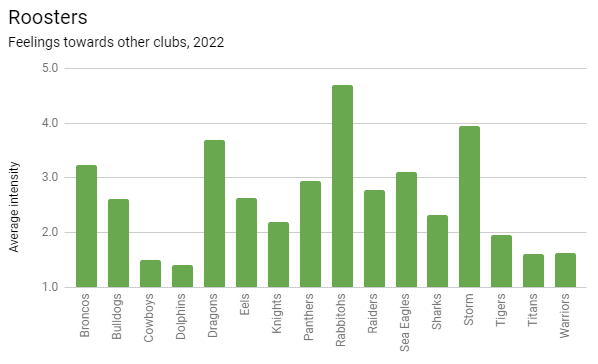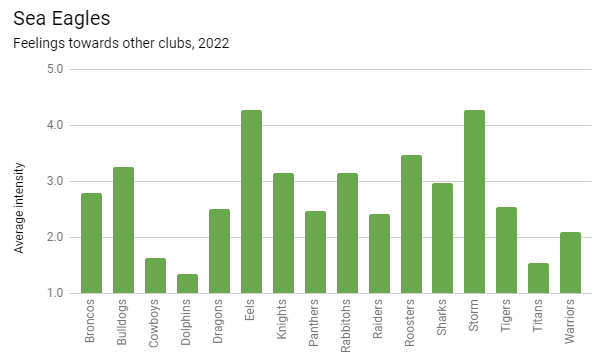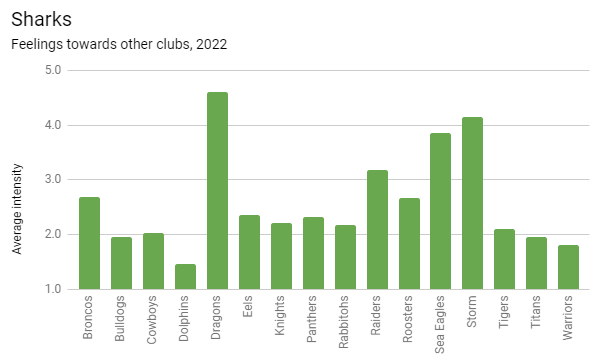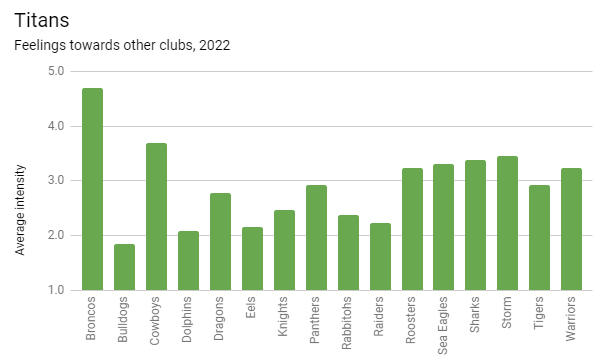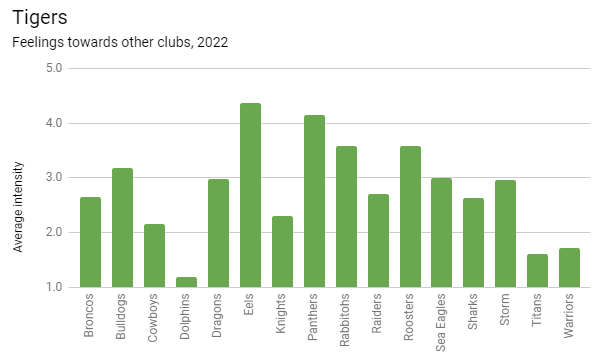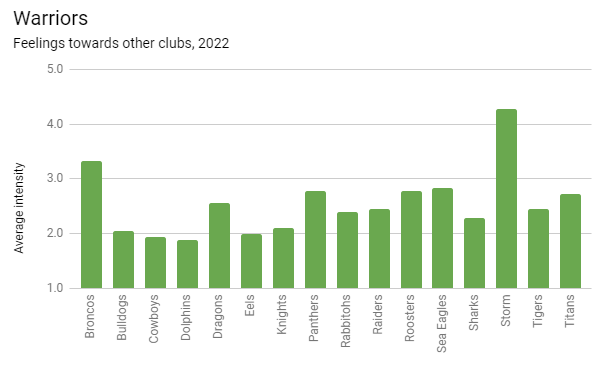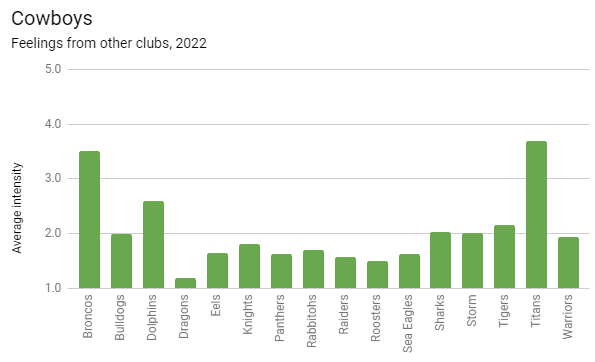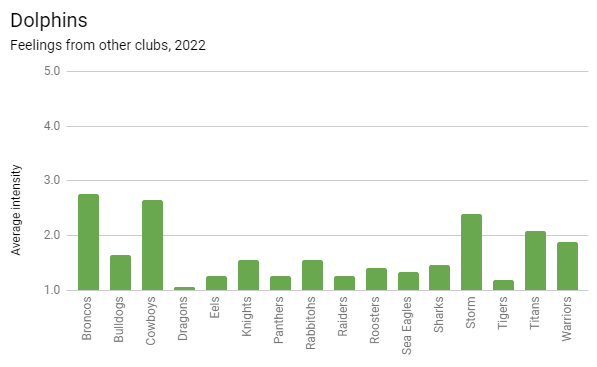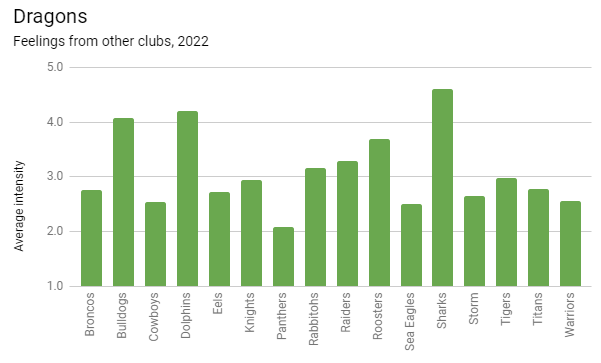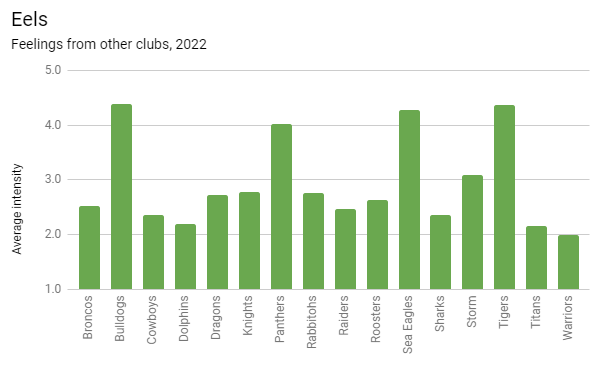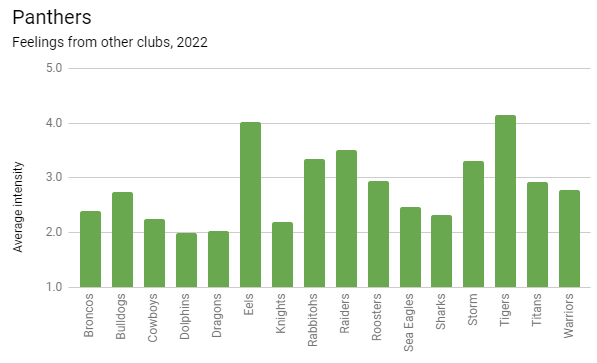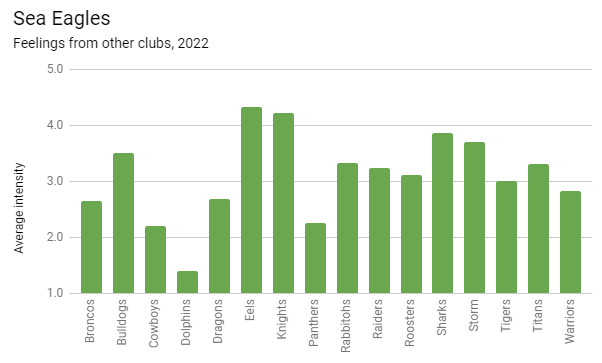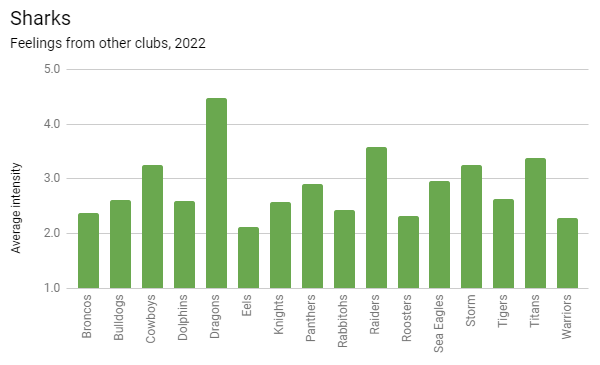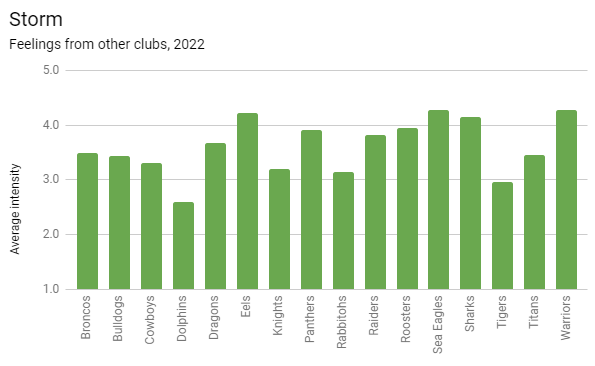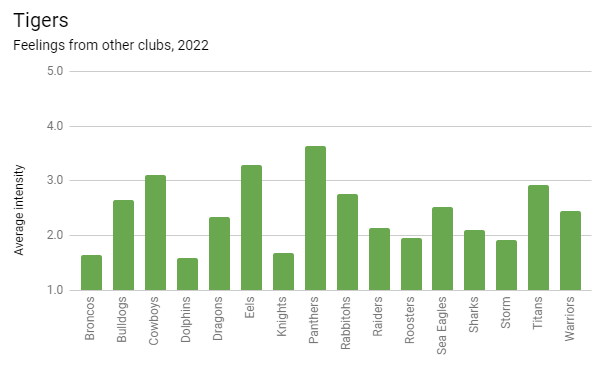The NRL broadcasters’ marketing really kicks into overdrive for a rivalry game. Often, this is framed as a long running grudge match between proximate Sydney suburbs that have been fighting the same grudge match for decades and sometimes the Broncos and Cowboys play a derby game. I’ve found it a little mystifying what gets played up as a rivalry and what doesn’t, often in the context of a grossly disproportionate focus on Sydney’s rivalries at the expense of the rest of the league.
A little while ago I came across Know Rivalry, which uses fan surveys to quantify rivalries in an array of sports. Since stumbling on their website and writing this post, they’ve added NRL and NRLW surveys so this is all now a complete waste of time, but in January, I asked people on Twitter to complete a similar survey to help quantify rivalry relationships in the NRL.
Here are the results.
Method
I tweeted this pre-season:
The link took you to a Google document, which asked which team you supported and then asked you rate the intensity of feeling you have towards other teams on a scale of 1 (least intense) to 5 (most intense). For the purposes of the analysis, all of the scoring for how people feel about their own teams was ignored.
The opposite of hatred is not love but is apathy
I’d like to thank for the following people for their impressive density of condescension crammed into single tweets:
Imagine proudly annoucing that not only did you not agree with how the survey was structured but that you had also decided to fill it in your own way, as if that was a helpful contribution. It’s just some of the most baffling shit but unfortunately, you have to wade through half a dozen dipshits to get a decent set of responses from Twitter.
Of course, it never occurred to these people men that do not follow me and have fewer than 100 followers that I understood what I was doing and had made a deliberate choice that might not be immediately intuitive but I thought might be more useful, even taking the risk that people might not respond as I wanted them to. It’s a blog, not a research paper.
To me, the nature of the rivalry is not always and uniformly negative. Rivalries have shades and hues. Roosters and Rabbitohs might hate each other for a century of stuff no one actually remembers. The Broncos and Cowboys rivalry has that too, over a shorter history, but also for a lot of people, represents a Queenslander-ly camaraderie. The rivalry is notionally no less intense but it has a different flavour, one that is not entirely built on pure hatred. Trying to capture the scope of human emotion in a single number that can be graphed is not an easy task.
Moreover, setting the apathy rating at the mid-point is effectively asking people which other clubs they like. I think that it’d be so rare and has so little to do with this exercise as to be completely useless information, which is why I didn’t ask that question.
Undoubtedly people, like our friend above, did not read the questions or understand them. Of 623 responses, one managed to not even respond to the first question which was, “Which team do you support?” (there were another half dozen non-responses to this that don’t seem to have been recorded in the final dataset). Fair enough, that was on me for not setting responses to be mandatory but at least we have a good gauge of the general quality of responses. Some people chose to not provide a rating for all teams but it’s rare enough that I don’t think it matters.
For the record, here’s the breakdown of responses to the first question:
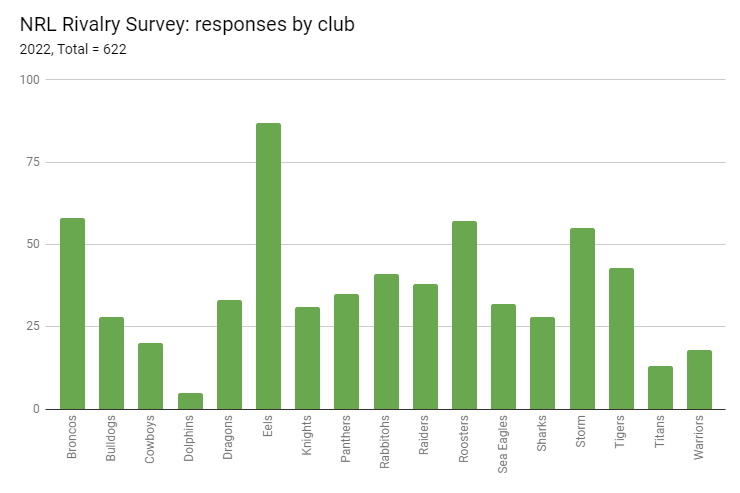
I’d been prepared to work with about a dozen responses per existing club, so about 200 all up, and closed the survey once the Titans had trickled over that mark. By that time, considerably more people from other clubs had responded.
Thanks to everyone who participated. The unedited response dataset can be downloaded here. The data is free to use but please attribute back to this page.
Intensity
Of the 134 rivalry pairings examined, about half were rated by both sides to be an average intensity of 2.5 or less. This is perhaps suggestive that the mean experience towards is not necessarily apathy but a low level simmering resentment. Or it could be that people rated their apathy as the mid-score, in which case I’m not sure how to interpret their 1s and 2s. The degree of simmering is very much still club driven, which we’ll break down later.
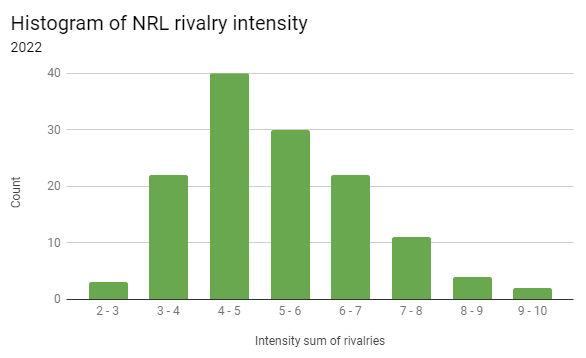
Of the 72 pairings rated at least a sum of 5 (an average intensity across both sides greater than 2.5), the bulk were made up in part by the Storm (15 appearances), Broncos (13), Roosters (12), Dragons and Sea Eagles (11 each) and Eels (10).
The top rated/most intensely felt rivalries were:
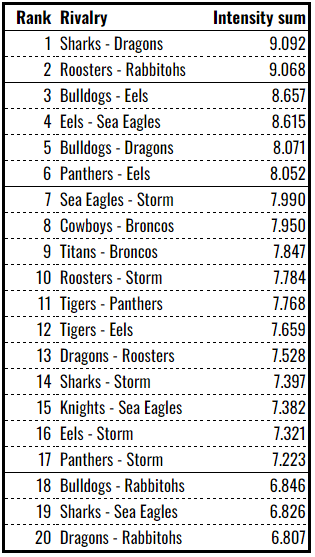
Because of the margin for error and sample size, I think its more instructive to take this less as a ranking and more as a tier-based exercise. There’s no meaningful difference between a score of 9.092 and 9.068 when you’re discussing the opinions of 60 to 100 (extremely online, very weird) people that are extrapolated to represent hundreds of thousands of normal fans.
On that basis, the NRL rivalries currently (somewhat arbitrarily) break down as follows:
- Tier A (sum of 9+): Sharks – Dragons, Roosters – Rabbitohs
- Tier B (sum of 8 to 9): Bulldogs – Eels, Eels – Sea Eagles, Bulldogs – Dragons, Panthers – Eels
- Tier C (sum of 7 to 8): Sea Eagles – Storm, Cowboys – Broncos, Titans – Broncos, Roosters – Storm, Tigers – Panthers, Tigers – Eels, Dragons – Roosters, Sharks – Storm, Knights – Sea Eagles, Eels – Storm and Panthers – Storm
Everything under a 7 is insufficiently intense to be considered a rivalry.
The good news is that the results accord to what we’d largely expect. You could arguably shuffle teams up and down tiers but for the most part, we’ve identified the most intense interclub relationships in the NRL.
That’s not to say that these values are fixed in time. If this survey were run at different times or responded to by different people, we’d get different results. If we did this exercise in 2016, there’s no doubt Broncos-Cowboys would be a top tier rivalry. Fast forward six years of forgettable results since for both clubs and the situation is decidedly more apathetic. Having said that, in breaking down the results, that seems to be coming from the Brisbane side of the equation and we can speculate whether that’s because Broncos fans are uniquely chill, barely raising a 3.5 for their dreaded rivals, uniquely stupid and unable to complete a survey properly, or completely dead inside.
In contrast, say what you like about the Sydney clubs, including their lack of pulling power to the stands and TVs, but their rivalries are old enough that they’re embedded in the bones of their fanbases. I have no idea what could fuel the Bulldogs – Dragons (the 1998 qualifying final?) but it’s apparently pretty potent. On the other hand:
Rent free
Not every rivalry is a perfect match up of immovable object and irresistable force. In fact, many of the relationships between clubs largely comprise a one-way flow of spite and invective.
The following shows the biggest gaps in intensity of feelings (e.g. the Knights rated the Broncos 3.7 but the Broncos rated the Knights only 1.9, resulting in a gap of 1.8), excluding the Dolphins’ responses:
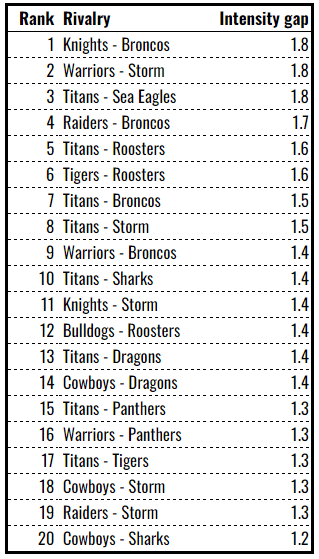
It’s not difficult to work out which club is living rent free in which heads, except for the Titans – Tigers relationship where it’s the Tigers living rent free in the Titans’ heads for some reason (Corey Thompson?). I’m going to chalk that up to small sample size.
They hate us because they ain’t us
Obviously there’s some common denominator clubs in these relationships, which we can quantify:

While the numbers themselves might be slightly skewed (the average is 2.7, which suggests again that some but not all respondents put apathy in the middle, rather than at the lower end), the trend is clear and I think if you were to rank clubs from most to least hated across the NRL fanbase, this would be a pretty good reflection.
We’re living in a dual golden age of Roosters and Storm dynastic dominance, so that explains the top two targets of other clubs’ ire. The Broncos have been good within living memory, are the historically pre-eminent Queensland club and also tried, rightfully, to destroy the culture of the sport in the mid-90s and a lot of people are still aggrieved about that for some reason. Manly is the traditionally hated club because of bullshit socio-economics Roy Masters managed to tap into, but will continue to slide down the standings due to a lack of profile (see low TV ratings) and increasing distance between now and their last premiership. After that, we enter the general morass of Sydney clubs, with Souths pushed to the top thanks to a latent hatred of the poor and shuffling will occur within this group based on recent success. After that, we find the expansion clubs bringing up the rear who, barring the Dolphins who have yet to play a NRL game, are almost sorted by their proximity to Sydney.
To breakdown into granular detail by club:
Each graph is a fingerprint for how each club fanbase relates to the other clubs, which probably informs how they see the league and sport as a whole.
Conclusions
If you were an administrator hellbent on making suburban tribalism the cornerstone of the game, I think there’s some interesting things to consider there. Firstly, we should probably draw a substantial but unquantifiable distinction between what people say they think and what people acutally do. People like Blake Solly would do well to remember this (refer earlier tweet) and if they can’t, then they should get out of the way.
Secondly, we might ask ourselves how clubs which aren’t featured prominently in rivalries, if they have sufficient tribalism to be part of the game’s future. Of the 16 current teams in the NRL, 14 are involved in at least one C-tier rivalry. The Warriors and Raiders are absent but for what it’s worth, Warriors – Storm rates 6.8 and Raiders – Roosters, 6.7, but they are very lopsided. I understand the value the Warriors and Raiders have but does the administration?
Thirdly, we can note the rivalries born not out of geography but come from finals clashes or simply teams being good for a prolonged period, resulting in repeated tense meetings that provide context for future battles. We discover that the nature of rivalry is not only multi-faceted but more flexible than is perhaps expected. I think there’s a certain amount of emotional space created by fans for rivalry and we do our best to fill it. If the Sharks and Dragons weren’t neighbours, those fans would pour that energy into something else. If Manly and Melbourne hadn’t played a series of grand finals (and spiteful subsequent meetings), those fans would find someone else to hate. Over time, they probably will.
We might also consider that a number of C-tier rivalries are intercity: Brisbane and Gold Coast, Brisbane and Townsville, Sydney and Melbourne. The meaning we give the NRL is also a fundmental driver, ratcheting up the intensity that we wouldn’t necessarily carry into spaces that we put less importance on. Suburban rivalries are real (somewhat to my surprise) and important but they’re not the only kind that exists. Taking this to its logical extreme, it may even be possible to manufacture rivalries with a deft enough touch, in which case, what value do pre-existing rivalries have if the concept of rivalry is at least somewhat fungible? Should the game be built around this concept to the exclusion of all else?
Finally, we might want to consider the impact of introducing a conference system to the sport and how this might alter these existing interclub relationships. The most commonly cited model is to split the league into Sydney and non-Sydney clubs. Putting aside the unnecessary refocussing of rugby league culture around Sydney and the completely uneven travel challenges and costs, this would be a disaster for some clubs. The Knights’ main rival is in Sydney and one of the Sea Eagles’ is outside of Sydney. The Raiders’ fans feel far more strongly about the Sydney clubs than the non-Sydney clubs. Attendances back this up. Do the benefits of conferences outweigh its costs?
Has anyone actually thought this through? You know the answer.
